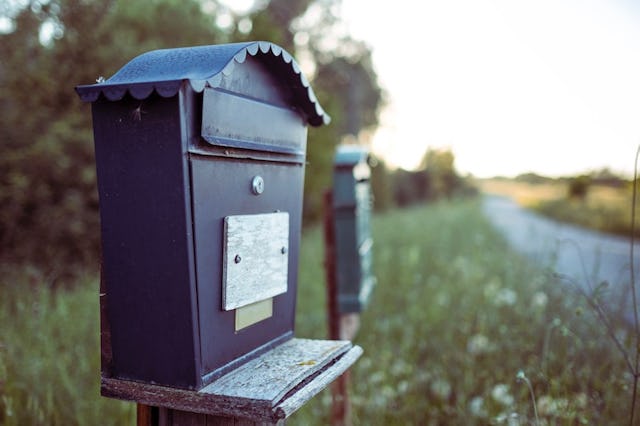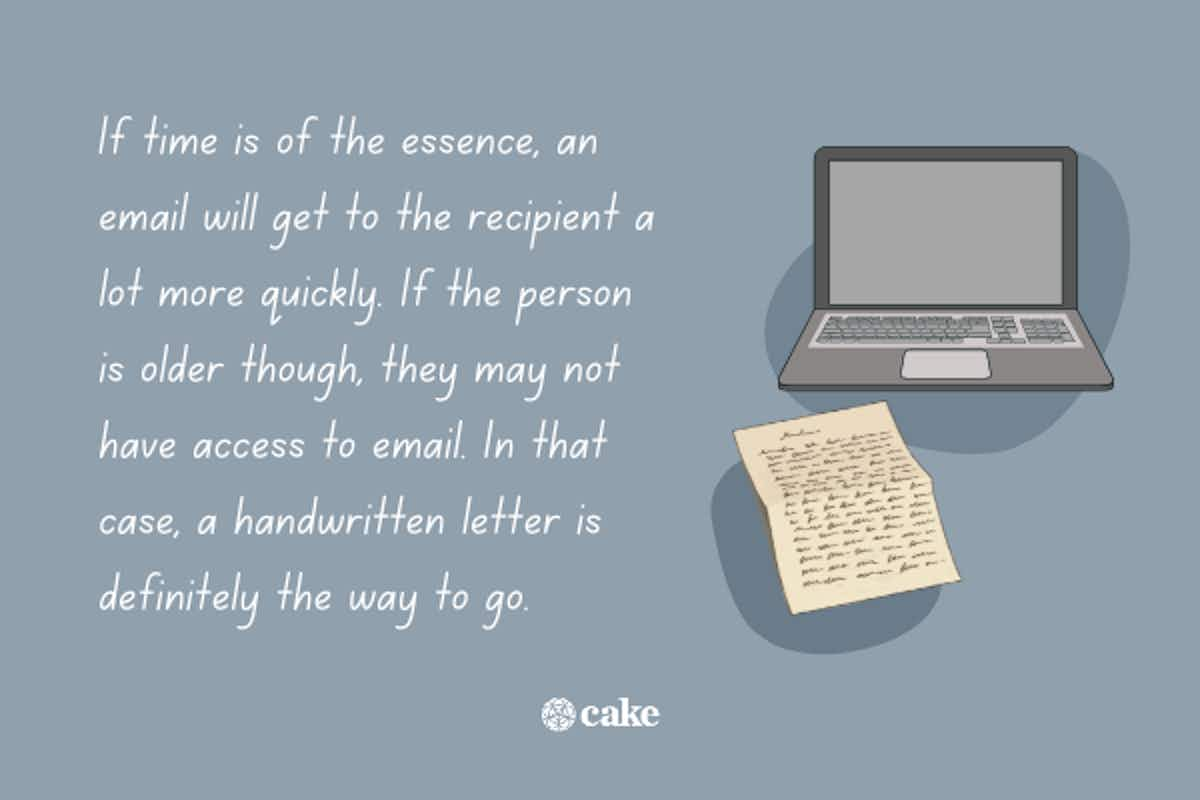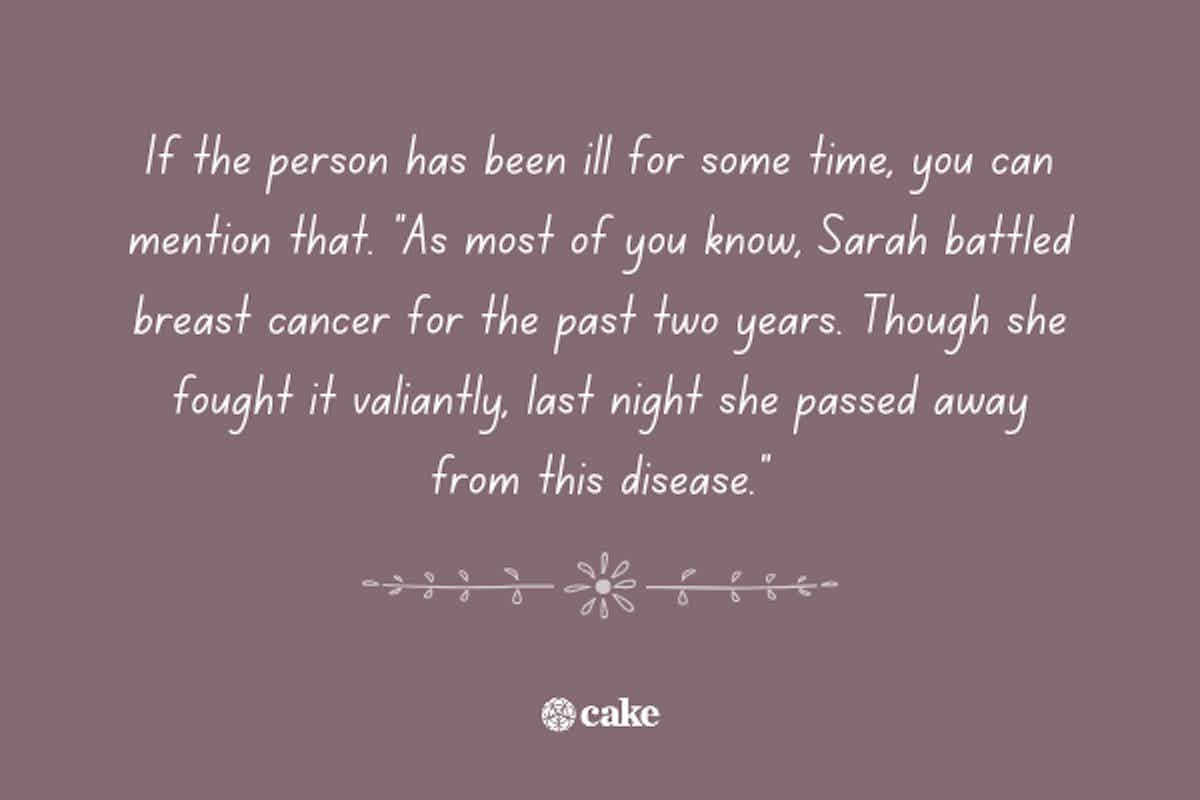How to Write a Death Notification Letter or Email to Friends
Updated
Published


Cake values integrity and transparency. We follow a strict editorial process to provide you with the best content possible. We also may earn commission from purchases made through affiliate links. As an Amazon Associate, we earn from qualifying purchases. Learn more in our affiliate disclosure.
When a close family member dies, you may be given the task of letting their friends know they have passed away. Word naturally gets out when a person dies. Obituaries and death notices may be published in a newspaper or online. Immediate family members often share on Facebook when someone dies.
Jump ahead to these sections:
- Step 1: Decide What Medium You’d Like To Use
- Step 2: Begin With a Formal Salutation
- Step 3: Begin With an Expression of Sympathy
- Step 4: Let People Know Some Details Surrounding Your Loved One’s Death
- Step 5: Talk About Plans for Ceremonies or Services for Mourners
- Step 6: Include Any Details on How People Can Reach Out to the Deceased’s Family
- Step 7: Include Something Personal About the Relationship Between the Letter’s Recipient and the Deceased
- Step 8: Close by Once Again Expressing Empathy and Regret
- Sample Death Notification Letter or Email to Friends
But for close friends, it’s important to try to reach out privately and one-on-one. The best way to do this is by putting together a letter or email that you can send to them directly.
If you’ve never notified people when a loved one has passed away or died, it can feel like a lot to take on. So we’ve put together a guide to help you break the news. Read on for tips and tricks, as well as some examples.
Post-planning tip: If you are the executor for a deceased loved one, it's tough to handle both the emotional and technical tasks of dealing with their unfinished business. We have a post-loss checklist that will help you ensure that your loved one's family, estate, and other affairs are taken care of.
Step 1: Decide What Medium You’d Like To Use

You can either hand-write an old-fashioned letter or send an email. There are pros and cons to both. A handwritten letter often feels both more formal and more personal than an email. However, a handwritten letter can take a few days to arrive.
If time is of the essence, an email will get to the recipient a lot more quickly. If the person is older though, they may not have access to email. In that case, a handwritten letter is definitely the way to go.
Step 2: Begin With a Formal Salutation
Even if you have a casual relationship with the recipient of your letter, a death notification should be formal.
Don’t start with something like, “Hey bro,” Instead, write “Dear Mike:”. If you don’t know the recipient of the letter well or at all, use a more proper form of address like “Dear Mr. Smith:”.
Step 3: Begin With an Expression of Sympathy
Even if you were close to the deceased, remember you’re breaking the news to someone who also cared for them a great deal.
Approach them with the same level of compassion you would want someone to come to you with. Acknowledge that you are sad or regretful to be the bearer of this news or tell them you’re sorry you have to be the one to let them know.
Step 4: Let People Know Some Details Surrounding Your Loved One’s Death

You don’t have to—nor should you—recount all the details of someone’s passing. But humans are curious by nature. We have a hard time processing the finality of death, and so we need to know some of the context to help us orient ourselves to the news.
If the person has been ill for some time, you can mention that. “As most of you know, Sarah battled breast cancer for the past two years. Though she fought it valiantly, last night she passed away from this disease.”
If the death was unexpected, you can still include some information. There’s no need for a blow by blow. Just a quick reference is all you need. For example, you could say something like, “Over the weekend, John was in a car accident. Sadly, he died as a result of his injuries.”
Other specific details you should be sure to include are the name of the deceased and the date of their death.
Step 5: Talk About Plans for Ceremonies or Services for Mourners
If there will be a memorial service or celebration of life ceremony for the deceased, this is the place to include the details. You can include the following:
- The date and time of the service
- The location of the service
- Any wardrobe requirements (for instance, a celebration of life ceremony may urge people to dress in bright colors instead of black)
- Details on where someone can donate in lieu of sending flowers
Tip: If you're planning a virtual funeral or memorial, some companies like GatheringUs have specialists who can guide and support you through the planning process.
Step 6: Include Any Details on How People Can Reach Out to the Deceased’s Family
Oftentimes, the person who sends out death notification letters like this is a family member or close friend of the deceased. However, they often aren’t the immediate family. This means that they are in a good position to know how people can support immediate family members while they grieve.
They can serve as an intermediary to communicate messages to the immediate family members. Or they can include information here on ways friends can support the family.
This is helpful to the people closest to the deceased. They don’t have to ask for the help they need. It’s also helpful for the recipient of the letter.
We don’t always know the best way to reach out to the family of the deceased. This can give some guidance. This isn’t information that has to be included, but it can be helpful.
Step 7: Include Something Personal About the Relationship Between the Letter’s Recipient and the Deceased
If someone was close enough to the deceased to warrant a personal letter, be sure to add some personal information if possible. An example of this would be, “You and Bob were so close since you were kids.
I know he appreciated how much you kept in touch with him throughout his illness. It meant a lot.” This kind of positive conclusion may help the letter’s recipient feel a little closure at the news.
Step 8: Close by Once Again Expressing Empathy and Regret

Whenever you’re breaking sad news to people, it’s good to offer them comfort again at the end of a notification letter.
Getting the news of a loved one’s death is hard, even if it isn’t a complete surprise. A little compassion goes a long way towards softening the blow.
Sample Death Notification Letter or Email to Friends
Now that we’ve broken down the best way to write a death notification letter, here are some examples of letters written based on those steps. You can use these as inspiration.
However, you should incorporate personalized details of your own to make them more specific to the memory of the deceased.
Example email one
Dear Mrs. Jones,
It is with much sadness that I write this letter to let you know that my Mom, Mary Danvers, has passed away. As you know, she was diagnosed with dementia several years ago. It was a tremendously difficult disease for her to live with. While we’re so sad she’s no longer with us, we are relieved to know she is finally at peace.
We will be holding a memorial service for Mom at her beloved place of worship, St. Luke’s Episcopal Church. It will be held on Saturday, August 14, 2020, at 2 pm. The address at St. Luke’s is:
4957 Copperthread Road
Cornwall, CT 06753
In lieu of flowers, we are asking that anyone who is able to make donations to the Dementia Society of America.
We’ve had people reach out to ask how they can support the family at this time. We don’t need meals or donations of any kind, as this isn’t something unexpected. We will be setting up a Facebook page though, so people can post their favorite memories of Mom during happier times.
You were such a wonderful friend to Mom over the years. I know her illness was so difficult for you. I want you to know, near the end, you were one of the few people she remembered. She really loved you.
Sincerely,
LeeAnn Danvers
Example email two
Dear Brian,
It breaks my heart to have to email you this news. Late last night, my brother Paul Roberts was killed in a car accident. As one of his closest friends since childhood, I wanted to let you know right away so you didn’t hear in the Facebook announcement we’ll be posting later.
While we don’t have any plans for a service yet, we’ll probably be organizing a celebration of life service for later this summer. As you know, Paul was practically allergic to being serious. He would hate having a traditional funeral. I’ll let you know when we know more details about how we want to honor his life.
Again, I’m so sorry to have to be the one to let you know this. You were at the house so much when we were kids. You were really like the brother Paul never had. I know this will be as hard for you as it is for the rest of our family.
Love,
Harper Roberts
Example email three
Dear Mr. Haynes,
I’m reaching out to break some sad news to you. My cousin, Owen Sandoval, passed away early Sunday morning after his long battle with cancer.
Owen’s funeral will be held on Sunday, August 23, 2020, at 4 pm. The service will be held at:
Morning Brothers Funeral Home
2243 Meadowcrest Lane
Danville, KY 40422
You meant a great deal to Owen. You took him under your wing in his class after he lost his dad. Your influence on his life led him into his own teaching career. He still spoke so highly of you. I’m sorry to have to inform you of his passing.
Sincerely,
Ross Lee
Tips, Tricks, and Examples on Crafting a Death Notification Letter
When someone dies, it’s important to get the word out to their friends so they don’t miss hearing it. The best way to make sure people get the news is to write an individual death announcement.
Taking a little time to write a letter or email ensures people aren’t blindsided hearing about the death of a friend through other sources. It’s hard to know exactly what to say when someone dies. But follow these tips and tricks, and you should be able to pen a beautiful and informative notification letter.



